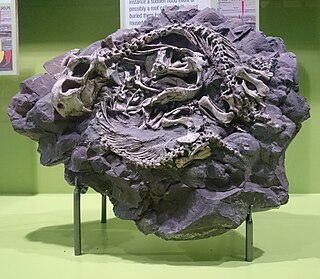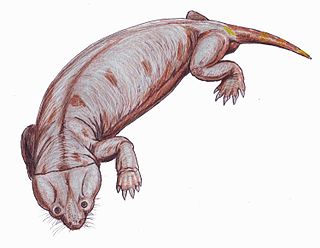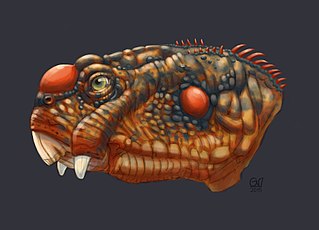
Diictodon is an extinct genus of pylaecephalid dicynodont that lived during the Late Permian period, approximately 255 million years ago. Fossils have been found in the Cistecephalus Assemblage Zone of the Madumabisa Mudstone of the Luangwa Basin in Zambia and the Tropidostoma Assemblage Zone of the Teekloof Formation, Tapinocephalus Assemblage Zone of the Abrahamskraal Formation, Dicynodon Assemblage Zone of the Balfour Formation, Cistecephalus Assemblage Zone of the Middleton or Balfour Formation of South Africa and the Guodikeng Formation of China. Roughly half of all Permian vertebrate specimens found in South Africa are those of Diictodon. This small herbivorous animal was one of the most successful synapsids in the Permian period.

The Beaufort Group is the third of the main subdivisions of the Karoo Supergroup in South Africa. It is composed of a lower Adelaide Subgroup and an upper Tarkastad Subgroup. It follows conformably after the Ecca Group and unconformably underlies the Stormberg Group. Based on stratigraphic position, lithostratigraphic and biostratigraphic correlations, palynological analyses, and other means of geological dating, the Beaufort Group rocks are considered to range between Middle Permian (Wordian) to Early Triassic (Anisian) in age.

Emydops is an extinct genus of dicynodont therapsids from the Middle Permian to Late Permian of what is now South Africa. The genus is generally small and herbivorous, sharing the dicynodont synapomorphy of bearing two tusks. In the following years, the genus grew to include fourteen species. Many of these species were erected on the basis of differences in the teeth and the positioning of the frontal and parietal bones. A 2008 study narrowed Emydops down to two species, E. arctatus and the newly described E. oweni.

The Tapinocephalus Assemblage Zone is a tetrapod assemblage zone or biozone which correlates to the middle Abrahamskraal Formation, Adelaide Subgroup of the Beaufort Group, a fossiliferous and geologically important geological Group of the Karoo Supergroup in South Africa. The thickest outcrops, reaching approximately 2,000 metres (6,600 ft), occur from Merweville and Leeu-Gamka in its southernmost exposures, from Sutherland through to Beaufort West where outcrops start to only be found in the south-east, north of Oudshoorn and Willowmore, reaching up to areas south of Graaff-Reinet. Its northernmost exposures occur around the towns Fraserburg and Victoria West. The Tapinocephalus Assemblage Zone is the second biozone of the Beaufort Group.

The Cistecephalus Assemblage Zone is a tetrapod assemblage zone or biozone found in the Adelaide Subgroup of the Beaufort Group, a majorly fossiliferous and geologically important geological group of the Karoo Supergroup in South Africa. This biozone has outcrops located in the Teekloof Formation north-west of Beaufort West in the Western Cape, in the upper Middleton and lower Balfour Formations respectively from Colesberg of the Northern Cape to east of Graaff-Reinet in the Eastern Cape. The Cistecephalus Assemblage Zone is one of eight biozones found in the Beaufort Group, and is considered to be Late Permian in age.

The Daptocephalus Assemblage Zone is a tetrapod assemblage zone or biozone found in the Adelaide Subgroup of the Beaufort Group, a majorly fossiliferous and geologically important geological Group of the Karoo Supergroup in South Africa. This biozone has outcrops located in the upper Teekloof Formation west of 24°E, the majority of the Balfour Formation east of 24°E, and the Normandien Formation in the north. It has numerous localities which are spread out from Colesberg in the Northern Cape, Graaff-Reniet to Mthatha in the Eastern Cape, and from Bloemfontein to Harrismith in the Free State. The Daptocephalus Assemblage Zone is one of eight biozones found in the Beaufort Group and is considered Late Permian (Lopingian) in age. Its contact with the overlying Lystrosaurus Assemblage Zone marks the Permian-Triassic boundary.

The Lystrosaurus Assemblage Zone is a tetrapod assemblage zone or biozone which correlates to the upper Adelaide and lower Tarkastad Subgroups of the Beaufort Group, a fossiliferous and geologically important geological Group of the Karoo Supergroup in South Africa. This biozone has outcrops in the south central Eastern Cape and in the southern and northeastern Free State. The Lystrosaurus Assemblage Zone is one of eight biozones found in the Beaufort Group, and is considered to be Early Triassic in age.

The Pristerognathus Assemblage Zone is a tetrapod assemblage zone or biozone which correlates to the upper Abrahamskraal Formation and lowermost Teekloof Formation, Adelaide Subgroup of the Beaufort Group, a fossiliferous and geologically important geological Group of the Karoo Supergroup in South Africa. The thickest outcrops, reaching not more than 300 metres (980 ft), occur just east of Sutherland through to Beaufort West in the south and Victoria West in the north. Exposures are also found west of Colesberg and south of Graaff-Reinet. The Pristerognathus Assemblage Zone is the third biozone of the Beaufort Group.

The Tropidostoma Assemblage Zone is a tetrapod assemblage zone or biozone which correlates to the lower Teekloof Formation, Adelaide Subgroup of the Beaufort Group, a fossiliferous and geologically important geological Group of the Karoo Supergroup in South Africa. The thickest outcrops, reaching approximately 240 metres (790 ft), occur from east of Sutherland through to Beaufort West and Victoria West, to areas south of Graaff-Reinet. Its northernmost exposures occur west/north-west of Colesberg. The Tropidostoma Assemblage Zone is the fourth biozone of the Beaufort Group.

The Eodicynodon Assemblage Zone is a tetrapod assemblage zone or biozone which correlates to the Abrahamskraal Formation, Adelaide Subgroup of the Beaufort Group, a fossiliferous and geologically important geological Group of the Karoo Supergroup in South Africa. The thickest outcrops, reaching approximately 620 metres (2,030 ft), occur south-east of Sutherland, north of Prince Albert, and south-east of Beaufort West. The Eodicynodon Assemblage Zone is the lowermost biozone of the Beaufort Group.

Theriognathus is an extinct genus of therocephalian therapsid belonging to the family Whaitsiidae, known from fossils from South Africa, Zambia, and Tanzania. Theriognathus has been dated as existing during the Late Permian. Although Theriognathus means mammal jaw, the lower jaw is actually made up of several bones as seen in modern reptiles, in contrast to mammals. Theriognathus displayed many different reptilian and mammalian characteristics. For example, Theriognathus had canine teeth like mammals, and a secondary palate, multiple bones in the mandible, and a typical reptilian jaw joint, all characteristics of reptiles. It is speculated that Theriognathus was either carnivorous or omnivorous based on its teeth, and was suited to hunting small prey in undergrowth. This synapsid adopted a sleek profile of a mammalian predator, with a narrow snout and around 1 meter long. Theriognathus is represented by 56 specimens in the fossil record.
Brachyprosopus is an extinct genus of dicynodont therapsid from the middle Permian Tapinocephalus Assemblage Zone in the Abrahamskraal Formation belonging to the Beaufort Group of the Karoo Basin, South Africa.

Daptocephalus is an extinct genus of non-mammalian synapsid anomodont dicynodont, it which was found in Late Permian strata, in a biozone known precisely for the presence of fossils of this dicynodont, the Daptocephalus Assemblage Zone, in the Karoo Basin in South Africa. An additional species, D. huenei, is known from the Usili Formation in Tanzania and was formerly assigned to the genus Dicynodon before a study in 2019 recognised that the type specimen belonged to Daptocephalus.

Eriphostoma is an extinct genus of gorgonopsian therapsids known from the Middle Permian of Tapinocephalus Assemblage Zone, South Africa. It has one known species, Eriphostoma microdon, and was first named by Robert Broom in 1911. It is the oldest known gorgonopsian and among the smallest and most basal members of the clade.
Elliotsmithia is a small varanopid synapsid found from the late Middle Permian of South Africa. It is the sole basal synapsid "pelycosaur" known from the supercontinent Gondwana and only two specimens have been yielded to date. Its species name longiceps is derived from Latin, meaning "long head". Both known Elliotsmithia fossils were recovered from Abrahamskraal Formation rocks—within the boundaries of the Tapinocephalus Assemblage Zone—of the lower Beaufort Group. It was named for the late Sir Grafton Elliot Smith in 1937.
Ictidognathus is an extinct genus of therocephalian therapsids that lived in South Africa during the Late Permian. Fossils are found in the Tropidostoma and Cistecephalus Assemblage Zones of the Beaufort Group in the Western Cape.

Dinanomodon is a genus of dicynodont from Late Permian (Changhsingian) of the Lystrosaurus Assemblage Zone, Katberg Formation, and Cistecephalus Assemblage Zone, Balfour Formation Beaufort Group, Karoo Basin of South Africa.

Langbergia is an extinct genus of trirachodontid cynodont from the Early Triassic of South Africa. The type and only species L. modisei was named in 2006 after the farm where the holotype was found, Langberg 566. Langbergia was found in the Burgersdorp Formation in the Beaufort Group, a part of the Cynognathus Assemblage Zone. The closely related trirachodontids Trirachodon and Cricodon were found in the same area.

Blattoidealestes is an extinct genus of therocephalian therapsid from the Middle Permian of South Africa. The type species Blattoidealestes gracilis was named by South African paleontologist Lieuwe Dirk Boonstra from the Tapinocephalus Assemblage Zone in 1954. Dating back to the Middle Permian, Blattoidealestes is one of the oldest therocephalians. It is similar in appearance to the small therocephalian Perplexisaurus from Russia, and may be closely related.

The Teekloof Formation is a geological formation that forms part of the Beaufort Group, one of the five geological groups that comprises the Karoo Supergroup in South Africa. The Teekloof Formation is the uppermost formation of Adelaide Subgroup deposits West of 24ºE and contains Middle to Late Permian-aged deposits and four biozones of the Beaufort Group. It overlies the Abrahamskraal Formation. The Teekloof Formation does not underlie other units other than the younger Karoo dolerites and sills that relate to the emplacement of the Early Jurassic Drakensberg Group to the east. Outcrops and exposures of the Teekloof Formation range from Sutherland through the mountain escarpments between Fraserburg and Beaufort West. The northernmost localities of the Teekloof Formation are found by Loxton, Victoria West and Richmond.






















